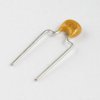Things are complicated, there is capacitance between turns so this will alter the distribution of current in the inductance. Also the effect of the capacitance will vary with frequency.
I measure the inductance with an inductance meter and also measure the self resonant frequency with a grid dip oscillator, then calculate what capacitance an ideal inductance would need to have in parallel to get the same effect. This is only an approximation.
An interesting exercise is to design an anode choke for a high power radio transmitter running at various frequencies.Sections of the choke can resonate and much smoke can be produced. Recommended designs are complicated with the inductance split into sections so that there are no resonances on required frequencies.
I measure the inductance with an inductance meter and also measure the self resonant frequency with a grid dip oscillator, then calculate what capacitance an ideal inductance would need to have in parallel to get the same effect. This is only an approximation.
An interesting exercise is to design an anode choke for a high power radio transmitter running at various frequencies.Sections of the choke can resonate and much smoke can be produced. Recommended designs are complicated with the inductance split into sections so that there are no resonances on required frequencies.

